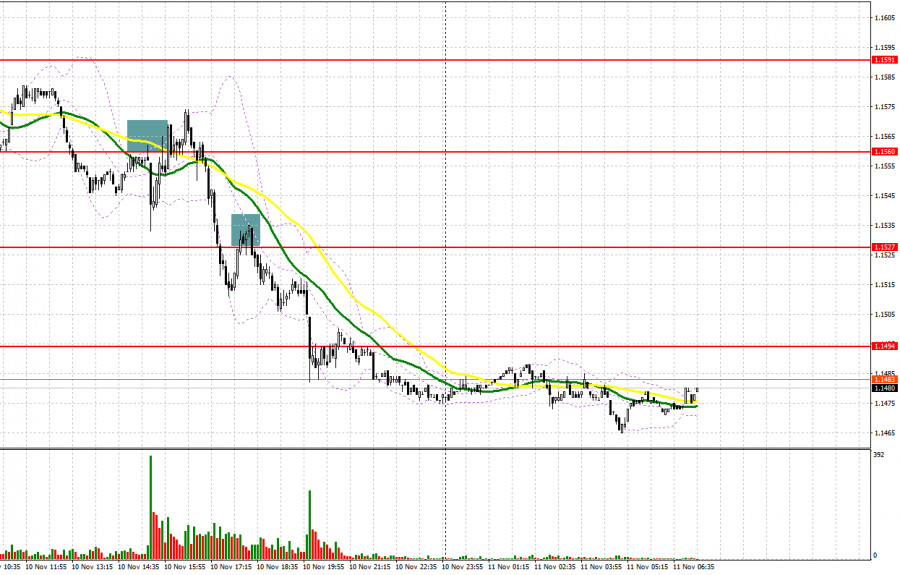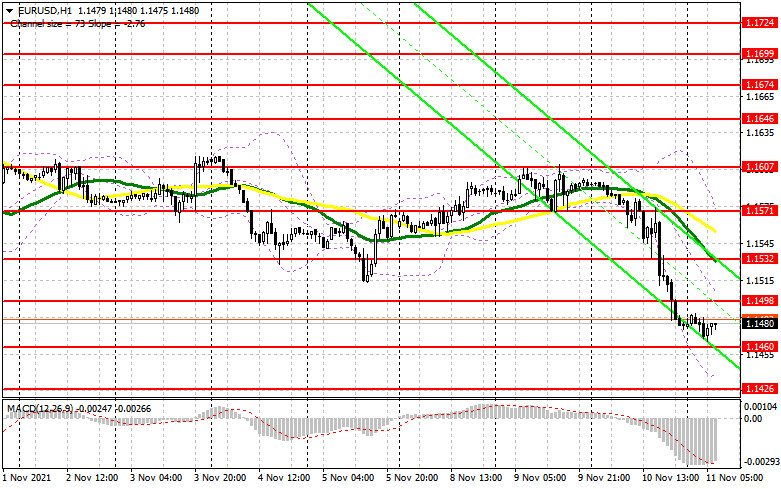To open long positions on EUR/USD, you need:
Quite a lot of signals to enter the market were formed yesterday. Let's take a look at the 5 minute chart and understand the trades. In the first half of the day, the euro bears tried to maintain the pressure that was formed after the release of data on inflation in Germany. The report was in line with economists' forecasts, which led to a downward movement of the pair and to a breakthrough of support at 1.1572. The bottom-up test of this level formed a good short entry point, which was perfectly implemented in the afternoon, which brought about 30 points in profit. After the release of a strong report on inflation in the US, the pressure on the euro returned. The bulls tried to rise above 1.1560, which resulted in forming a new signal to open short positions, followed by a collapse of EUR/USD by 70 points.

Today, there are no important statistics on the European economy, so all attention will be drawn to the release of the economic bulletin from the European Central Bank and the forecast for the economy from the European Commission. If economists consider inflationary pressures in the eurozone insufficient for more aggressive measures by the central bank, the pressure on the euro will increase. The bulls will try to get back into the market, but in order to stop the large bearish trend they need to get out of the 1.1498 range. Only a reverse test from top to bottom of this range after the release of forecasts from the European Commission will provide a point of entry into long positions, counting on the growth of EUR/USD to the 1.1532 area. There are moving averages that play on the bears' side, which will limit the pair's upward potential. Only a breakthrough of this range and a test from top to bottom will lead to another buy signal and the pair's growth to the high of 1.1571, where I recommend taking profits. If the pressure on EUR/USD persists in the first half of the day, forming a false breakout in the 1.1460 area along with the divergence on the MACD indicator will limit the euro's fall and result in forming a signal to open long positions with the goal of an upward correction of the pair. In case traders are not active at 1.1460, it is best to wait for the formation of a false breakout in the 1.1426 area, but you can open long positions in EUR/USD immediately for a rebound from a low like 1.1371, counting on a correction of 15-20 points within the day.
To open short positions on EUR/USD, you need:
The bears control the market and all they need is to protect 1.1498. The whole calculation in the first half of the day will be for bad forecasts from the European Commission and the formation of a false breakout at the level of 1.1498. This forms the first signal to open short positions, which will provide an excellent point in the market with the goal of falling to the support of 1.1460. A breakthrough and test of this area from the bottom up will increase pressure on EUR/USD, which will open the way to the lows: 1.1426 and 1.1371. I recommend taking profits on short positions there, since volatility will be at a fairly low level in the afternoon due to the holiday in the US. In case the euro rises during the European session and the bears are not active around 1.1498, I advise you to postpone short positions until the next resistance test at 1.1532. But even there, it is best to open short positions after the formation of a false breakout. The best option for selling EUR/USD immediately on a rebound will be a high around 1.1571. You can count on a downward correction of 15-20 points.

I recommend for review:
The Commitment of Traders (COT) report for November 2 revealed a decrease in both long and short positions, which led to a negative delta since more sellers had exited the market than buyers. The monetary policy meetings of the leading central banks last week had a minor impact on the market. The Fed's stance on monetary policy boosted investors' optimism and restored faith in the continuing economic recovery. At the same time, expectations that the ECB, despite all its statements, will have to tighten its policy soon amid rising inflation give EUR a chance to recover in the intermediate term. With each new fall in price, demand for the euro increases. Tomorrow, the United States will deliver its inflation report. The greenback's future movement versus its main counterparts depends on its outcome. According to the COT report, long non-commercial positions declined to 191,496 from 196,880 and short non-commercial positions fell to 197,634 from 208,136. The total non-commercial net position recovered slightly to -6,388 versus -11,256. The weekly closing price dropped to 1.1599 from 1.1608.
Indicator signals:
Trading is carried out below the 30 and 50 daily moving averages, which indicates a bear market.
Moving averages
Note: The period and prices of moving averages are considered by the author on the H1 hourly chart and differs from the general definition of the classic daily moving averages on the daily D1 chart.
Bollinger Bands
In case of growth, the upper border of the indicator in the area of 1.1571 will act as a resistance. In case of a decline, the lower border of the indicator at 1.1440 will act as a support.
Description of indicators
- Moving average (moving average, determines the current trend by smoothing out volatility and noise). Period 50. It is marked in yellow on the chart.
- Moving average (moving average, determines the current trend by smoothing out volatility and noise). Period 30. It is marked in green on the chart.
- MACD indicator (Moving Average Convergence/Divergence — convergence/divergence of moving averages) Quick EMA period 12. Slow EMA period to 26. SMA period 9
- Bollinger Bands (Bollinger Bands). Period 20
- Non-commercial speculative traders, such as individual traders, hedge funds, and large institutions that use the futures market for speculative purposes and meet certain requirements.
- Long non-commercial positions represent the total long open position of non-commercial traders.
- Short non-commercial positions represent the total short open position of non-commercial traders.
- Total non-commercial net position is the difference between short and long positions of non-commercial traders.
from RobotFX



No comments:
Post a Comment